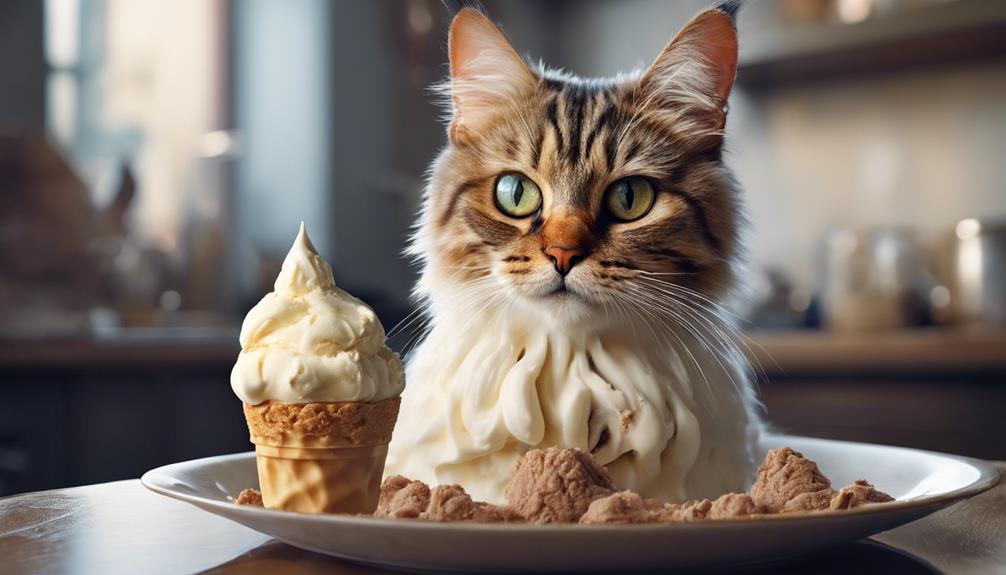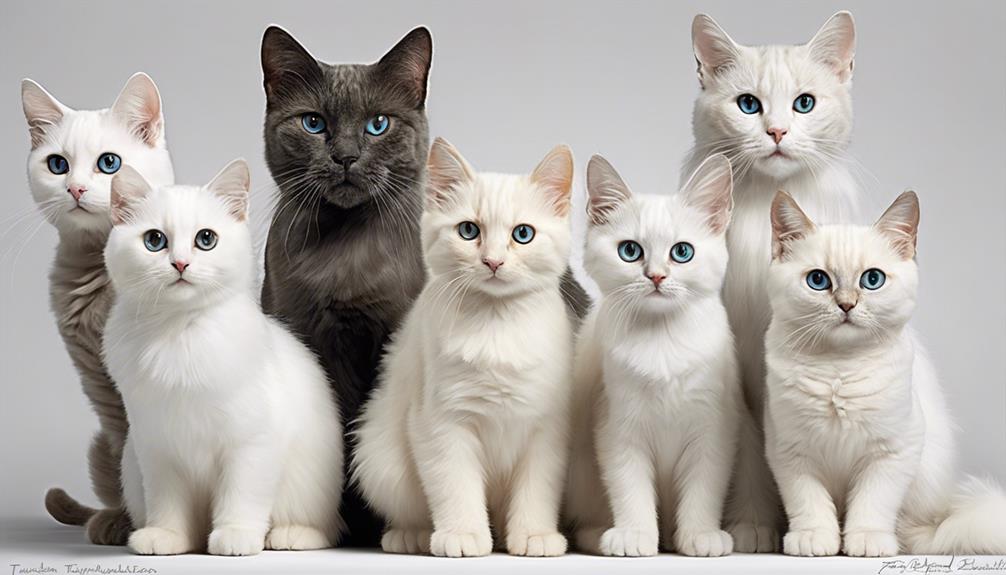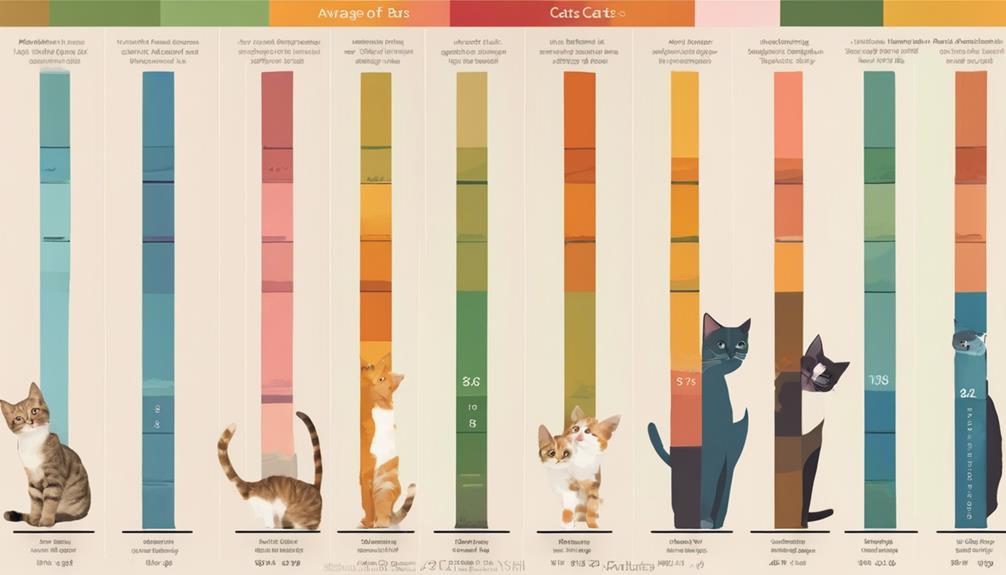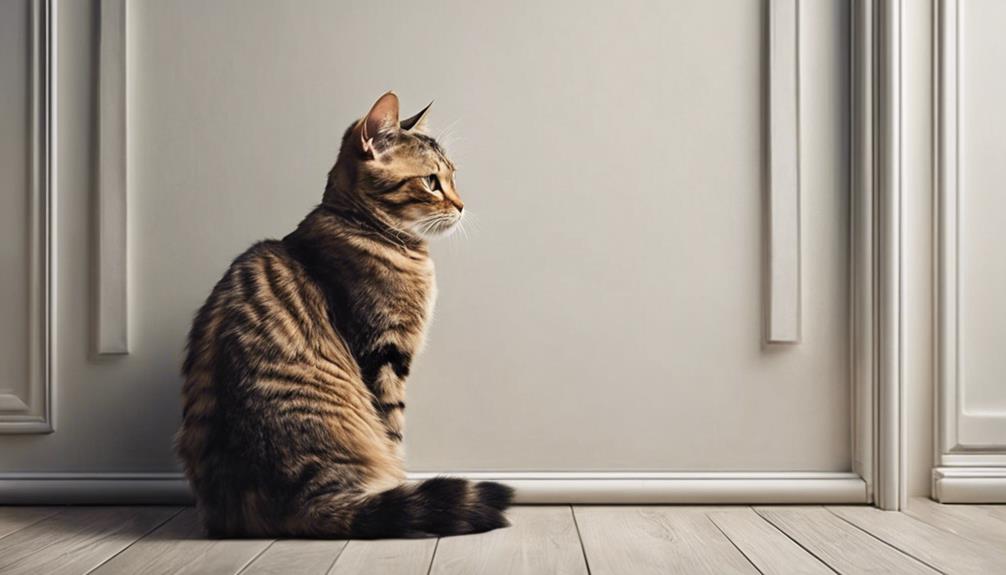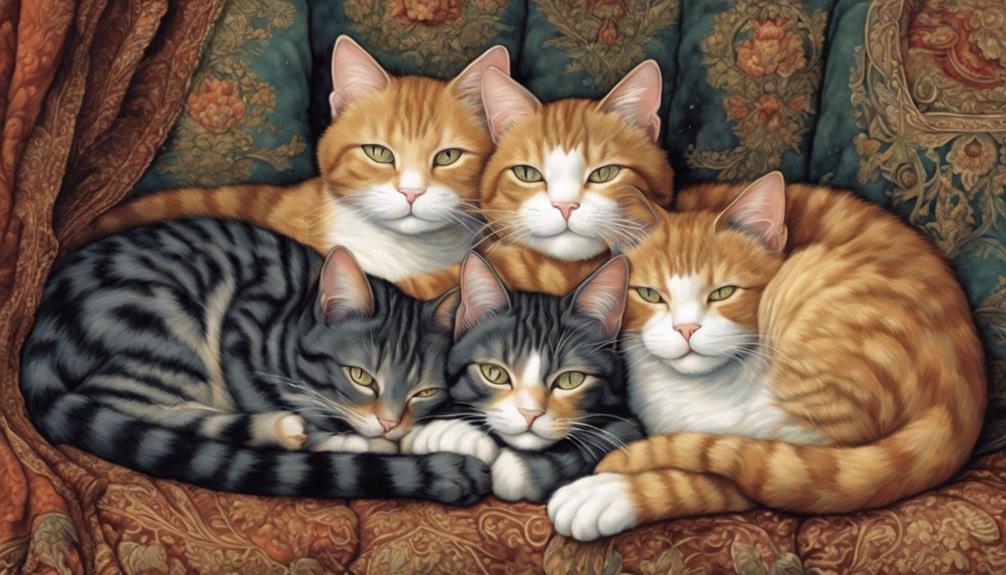Cats should steer clear of ice cream. It can lead to troubles like lactose intolerance and obesity. Play it safe by opting for cat-friendly treats. Ice cream packs loads of sugar that can stir up health issues. Stick with nutritious options for your feline friend. Treats like chocolate and xylitol are no-goes for cats. Consider gentle non-dairy choices if you're craving ice cream for your cat. Want to know more about safe treats? Keep discovering to keep your furry pal healthy and happy!
Key Takeaways
- Cats should avoid regular ice cream due to lactose intolerance and high sugar content.
- Ice cream can contain toxic ingredients like chocolate, nuts, and xylitol harmful to cats.
- Opt for cat-specific treats or non-dairy alternatives to ensure feline safety.
- Excessive ice cream consumption can lead to weight gain, obesity, and health issues.
- Cat ice cream, made with safe ingredients, is a better occasional treat option for cats.
Cats and Ice Cream: Compatibility Concerns
When thinking about cats and ice cream, it's important to prioritize their well-being over our desire to share treats with them. Cats eating ice cream may seem harmless, but it can actually be quite harmful. Ice cream often contains toxic ingredients like chocolate, raisins, and artificial sweeteners, which can be dangerous for our feline friends. Even plain vanilla ice cream isn't recommended for cats due to the dairy content and potential health risks it poses.
As much as we may want to treat our cats to a little indulgence, it's essential to remember that regular consumption of ice cream can contribute to weight gain and obesity in cats. Their delicate digestive systems aren't equipped to handle the lactose and high sugar content found in ice cream. To safeguard their well-being and avoid any complications, it's best to stick to cat-specific treats and foods that are safe and nutritious for them.
Let's show our love for our furry companions by keeping them healthy and happy.
Lactose Intolerance in Cats
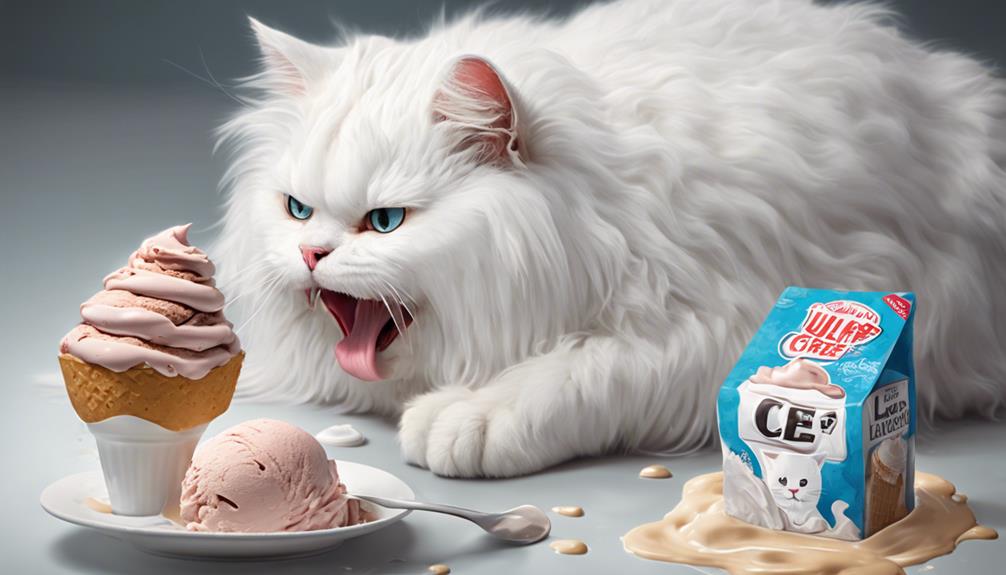
Discussing lactose intolerance in cats, it's important to note that adult cats are generally lactose intolerant due to decreased production of the enzyme lactase. This means that dairy products can wreak havoc on their digestive systems, leading to unpleasant symptoms like diarrhea, flatulence, and abdominal pain.
While kittens can initially digest lactose due to producing lactase, this ability diminishes as they grow older, making them lactose intolerant too. It's vital to recognize that many cats exhibit adverse reactions to dairy products, highlighting the risks of offering them treats like ice cream.
Understanding the implications of lactose intolerance in cats can help us make informed decisions about their diet. Avoiding dairy products, including ice cream, is typically recommended to prevent digestive issues and discomfort in our feline friends. By being mindful of their unique dietary needs and sensitivities, we can guarantee that our cats stay happy and healthy without the risks associated with lactose intolerance.
Sugar Content Risks for Felines
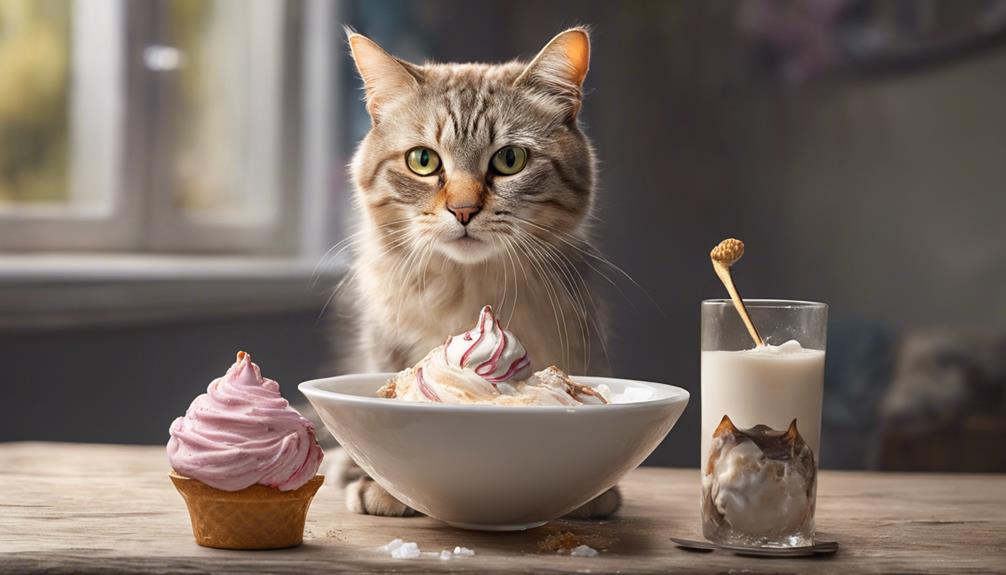
When discussing cats and ice cream, we must be mindful of the sugar content. High sugar levels in ice cream can result in weight gain, diabetes, and other health concerns in felines.
Monitoring their sugar intake is crucial, choosing moderation to preserve their well-being.
Sugar and Cats
Monitoring a cat's sugar intake is vital to prevent health complications and maintain their well-being. While cats may not have a natural affinity for sweet flavors, it's important to be mindful of the sugar content in their diet.
Excessive sugar consumption can lead to weight gain, obesity, and even diabetes in felines. Additionally, sugar can disrupt a cat's metabolism and overall health, impacting their well-being. Dental issues such as cavities and tooth decay can also arise from high sugar intake in cats.
Health Concerns
To protect our feline companions' well-being, we must be cautious of the potential health risks posed by high sugar content in foods like ice cream. Cats are sensitive to sugar, and indulging in this sweet treat can lead to various health concerns.
The excessive sugar in ice cream can contribute to weight gain and obesity in cats, impacting their overall health. In addition, consuming ice cream with high sugar content may result in gastrointestinal issues such as vomiting and diarrhea for our beloved feline friends.
Regular intake of sugary treats like ice cream can even increase the risk of diabetes in cats, underscoring the importance of monitoring their diet closely. It's essential to prioritize our cats' health by avoiding feeding them ice cream and opting for healthier alternatives instead.
Moderation Is Key
In considering the sugar content risks for felines, moderation is essential to safeguard their health and well-being. Cats are lactose intolerant, and indulging in ice cream can lead to digestive problems, such as vomiting and diarrhea. To emphasize the importance of moderation, let's take a closer look at the potential risks:
| Risk | Description |
|---|---|
| Weight Gain | High sugar content in ice cream can cause obesity. |
| Digestive Issues | Excessive consumption may lead to GI disturbances. |
| Toxic Ingredients | Ice cream may contain harmful substances for cats. |
Toxic Ingredients to Avoid
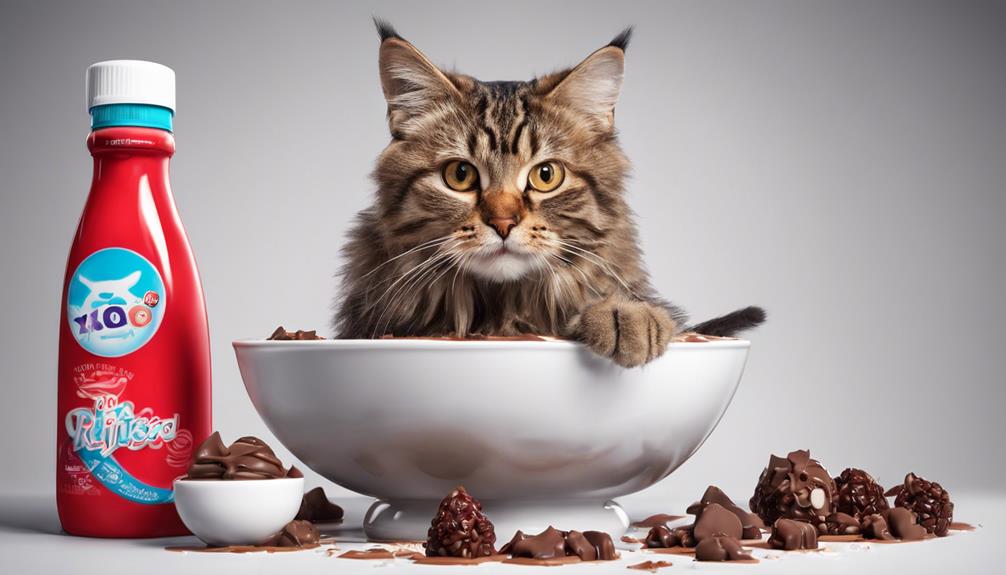
Ice cream can contain harmful ingredients for cats like chocolate, raisins, nuts, and xylitol. These can pose serious health risks to our feline friends, even in small quantities.
It's important to be vigilant and avoid feeding ice cream with these toxic ingredients to keep our cats safe and healthy.
Harmful Ingredients List
Containing harmful ingredients such as chocolate, raisins, nuts, and xylitol, ice cream poses serious health risks to cats. These toxic ingredients can lead to severe health issues or even be fatal to our feline friends. Even small amounts of these substances in ice cream can result in poisoning in cats. It's crucial to always check the ingredients of ice cream before sharing it with your cat to guarantee their safety. Below is a table outlining some common harmful ingredients found in ice cream that are toxic to cats:
| Toxic Ingredient | Potential Effects on Cats |
|---|---|
| Chocolate | Vomiting, diarrhea, rapid breathing |
| Raisins | Kidney failure, lethargy, weakness |
| Nuts | Upset stomach, muscle tremors, hind leg weakness |
| Xylitol | Hypoglycemia, liver failure, seizures |
Safe Alternatives for Cats
When selecting treats for our feline companions, it's important to avoid ice cream options that include harmful ingredients such as chocolate, raisins, nuts, and xylitol. Here are some safe alternatives for cats to enjoy:
- Non-dairy ice creams made with nut milks, soy milk, or oat milk can be a tasty option for our lactose intolerant feline friends.
- Opt for non-toxic varieties of frozen treats to guarantee your cat's safety and well-being.
- Remember that even non-dairy ice creams can be high in calories, so it's best to offer them in very small amounts occasionally to prevent weight gain and obesity in cats.
Potential Health Risks
To safeguard our cats' health, it's imperative to steer clear of ice cream varieties containing hazardous ingredients like chocolate, raisins, nuts, and xylitol. These toxic components can pose serious health risks to our feline friends, even in small amounts. Here's a helpful table outlining the toxic ingredients to avoid in ice cream for cats:
| Toxic Ingredients | Potential Harm for Cats | Common Sources |
|---|---|---|
| Chocolate | Toxic to cats' nervous system | Some chocolate-flavored ice creams |
| Raisins | Can cause kidney failure | Ice cream with raisin mix-ins |
| Nuts | Digestive issues and allergies | Nutty ice cream varieties |
Non-Dairy Alternatives for Cats
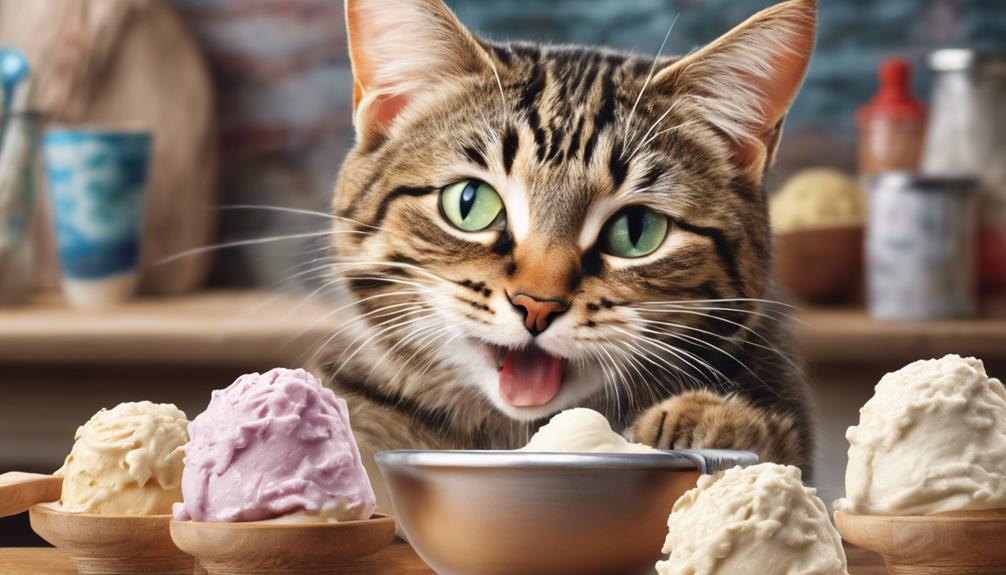
Non-dairy alternatives for cats provide a safe option for occasional indulgence without the risks associated with traditional ice cream. When considering treats for your feline friend, keep in mind the following:
- Non-dairy ice creams: Opt for specifically formulated non-dairy ice creams made for cats to guarantee they don't contain harmful ingredients.
- Toxic ingredients: Avoid non-dairy alternatives with toxic substances like chocolate or xylitol, which can be dangerous for cats.
- Variety of bases: Explore alternatives made from nut milks, soy milk, and oat milk to offer a diverse range of flavors for your cat's enjoyment.
These options offer a way to treat your cat without the potential health risks associated with traditional ice cream. Remember, moderation is key to maintaining your cat's health and weight, so indulge them in small amounts occasionally to keep them happy and healthy.
Moderation and Health Considerations
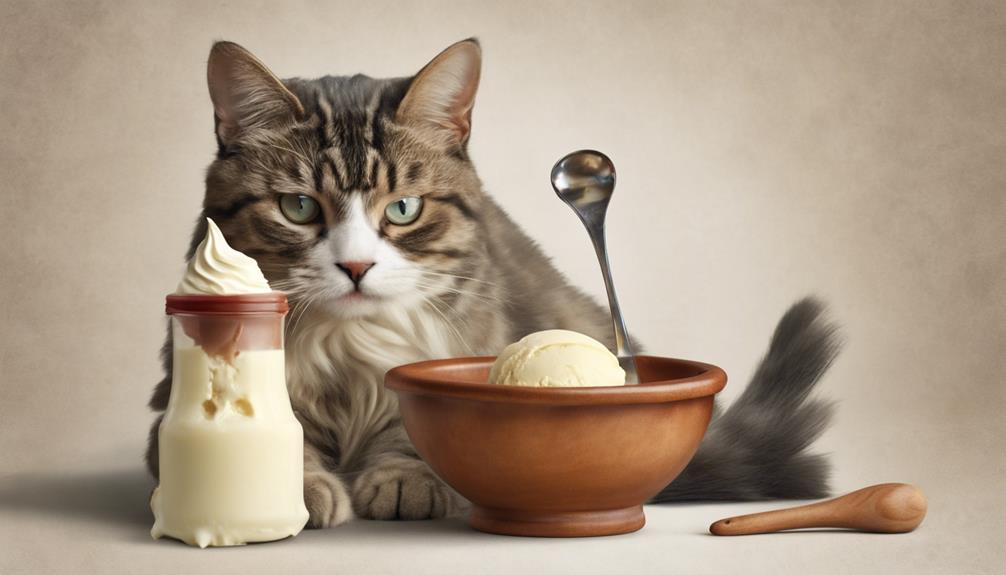
When it comes to feeding cats ice cream, it's important to be mindful of their digestion, as many felines are lactose intolerant.
The high sugar and fat content in ice cream can have a significant impact on a cat's health, potentially leading to obesity if consumed excessively.
Considering these factors, it's vital to approach giving ice cream to cats with caution and in small, occasional portions to prevent any adverse effects on their well-being.
Cats Digestion of Dairy
Cats' ability to digest dairy is limited due to decreased lactase production as they age. When it comes to dairy consumption, cats can be sensitive creatures. Here are a few key points to keep in mind:
- Cats may be lactose intolerant, leading to digestive issues like diarrhea and flatulence.
- Kittens produce lactase to digest their mother's milk but lose this ability as they mature.
- Dairy products, including ice cream, can cause adverse reactions in many cats due to lactose intolerance.
Understanding your feline friend's digestive system is vital for their well-being. So, when it comes to offering treats like ice cream, it's best to err on the side of caution.
Sugar Content Impact
How does the high sugar content in ice cream impact a cat's health and well-being when consumed in excess?
Cats are known to be obligate carnivores, meaning their ideal diet consists mainly of meat. Hence, their bodies aren't designed to handle large amounts of sugar and fat found in ice cream. Excessive consumption can lead to weight gain, potentially causing obesity and related health issues.
Additionally, the high sugar content in ice cream can also have negative effects on cats' dental health and increase the risk of developing diabetes. To guarantee your cat's well-being, it's vital to monitor their intake of sugary treats like ice cream and focus on providing a balanced diet that meets their nutritional needs without overloading them with harmful ingredients.
Potential Lactose Intolerance
Understanding the potential risks of lactose intolerance in cats is vital for making informed decisions about offering treats like ice cream. When considering your feline friend's digestive health, it's essential to keep in mind the following:
- Most adult cats are lactose intolerant, making it difficult for them to digest dairy products like ice cream.
- Feeding ice cream to cats can result in digestive issues such as diarrhea, bloating, and stomach discomfort due to their lactose intolerance.
- Regular or excessive consumption of ice cream can lead to gastrointestinal upset and discomfort in cats, emphasizing the importance of moderation and awareness of their potential lactose intolerance.
Nut Milk Options for Cats
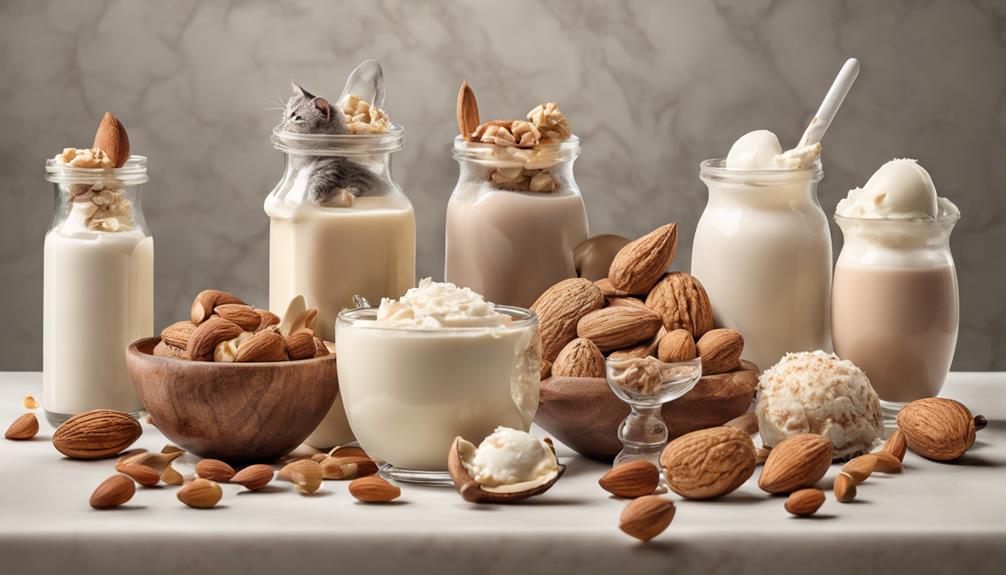
Exploring nut milk options can offer a lactose-intolerant cat a creamy and nutritious alternative to regular dairy milk. Nut milk options like almond milk, cashew milk, and coconut milk can be suitable choices for cats with lactose intolerance. These non-dairy alternatives provide a creamy texture similar to regular milk but without the lactose content that can upset a cat's stomach. Nut milks are often vital with vitamins and minerals, potentially offering health benefits when consumed in moderation.
When choosing nut milks for your feline friend, opt for unsweetened and unflavored varieties to steer clear of added sugars or artificial ingredients that may be harmful to cats. It's essential to introduce nut milks gradually into your cat's diet to monitor for any signs of digestive issues or allergies before incorporating them regularly. By being mindful of your cat's nutritional needs and preferences, you can find a suitable nut milk option that your furry companion will enjoy and benefit from.
Soy Milk as a Safer Choice
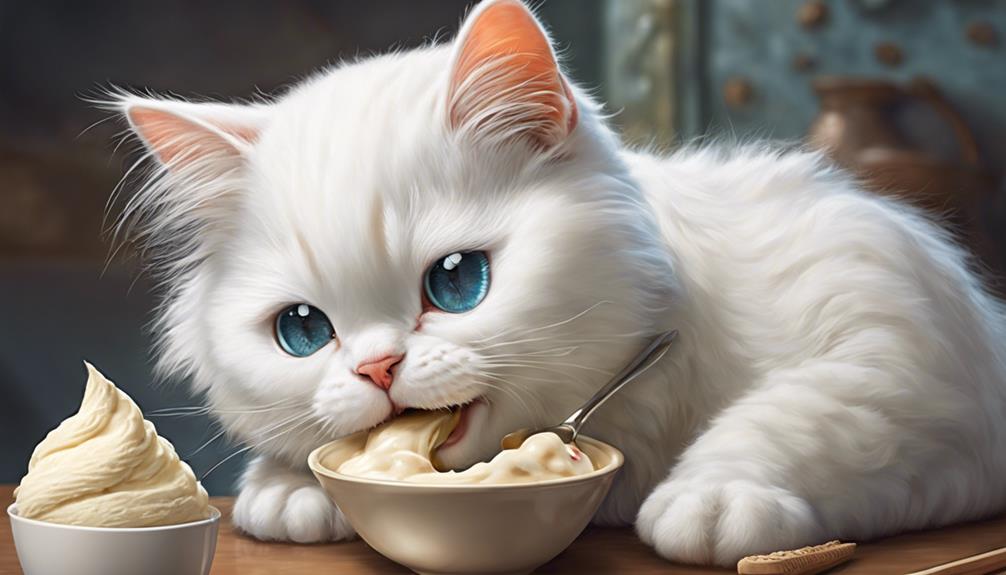
Soy milk offers various benefits for cats, serving as a dairy-free alternative that's easy on their stomachs. It provides essential amino acids crucial for their health, making it a cat-friendly ingredient to consider.
Opting for unsweetened varieties avoids unnecessary sugar intake, ensuring a safer choice for your feline friend.
Soy Milk Benefits
Opting for soy milk as a lactose-free alternative can be a wise choice for cats prone to digestive issues related to dairy consumption. Here are three compelling reasons why soy milk benefits feline friends:
- Critical: Soy milk is a safe option for cats who are lactose intolerant, preventing stomach discomfort.
- Plant-based: Being a dairy-free, plant-based alternative, soy milk reduces the risk of digestive problems in cats.
- Packed with protein: This milk alternative is filled with essential proteins critical for a cat's overall health and well-being.
Choosing soy milk over traditional dairy products like cow's milk can lead to a happier and healthier kitty.
Dairy-Free Alternative
When considering a dairy-free alternative for cats, soy milk emerges as a safer choice, especially in the context of creating cat-friendly ice cream.
Cats, often lactose intolerant, can benefit from soy milk's plant-based nature, devoid of lactose that may trigger digestive issues.
By using soy milk in ice cream, the minimize the risk of gastrointestinal problems in cats is minimized, offering a suitable option for feline companions who relish this frozen delight.
Not only does soy milk provide a dairy-free solution for cat ice cream, but it also guarantees a smoother digestion process for our furry friends.
Cat-Friendly Ingredient
For cat owners looking to provide their feline companions with a dairy-free frozen treat, incorporating soy milk into homemade ice cream can be a wise and cat-friendly choice. Here are a few reasons why soy milk is a safer option for lactose-intolerant cats:
- Soy milk is a cat-friendly alternative to dairy, ensuring your feline friend can enjoy a frozen treat without digestive issues.
- It offers a lactose-free option, preventing discomfort commonly associated with traditional dairy products.
- Being a source of plant-based protein, soy milk not only caters to your cat's dietary needs but also promotes better digestion and overall health.
Oat Milk for Feline Treats
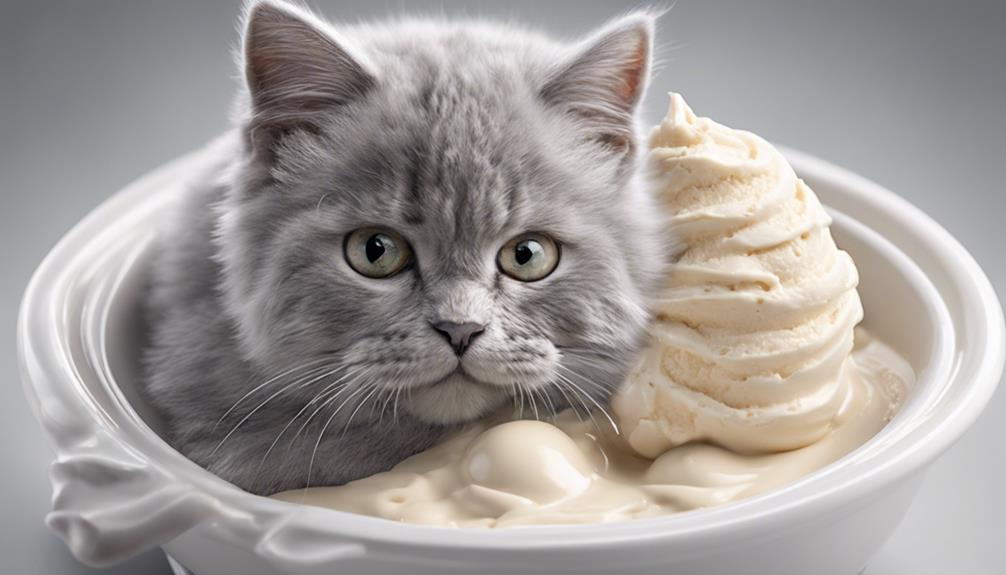
Oat milk offers a lactose-free alternative for creating delightful feline treats. This non-dairy option is a great choice for cats with lactose intolerance, as it's easier on their stomachs compared to regular dairy products.
Using oat milk to make ice cream treats for our feline friends can be a safe and delicious way to indulge them. When incorporating oat milk into their treats, it's important to confirm that all other ingredients are safe and non-toxic for our furry companions.
Moderation is key when offering these oat milk-based goodies to our cats, providing a tasty and healthier substitute for traditional ice cream that they can enjoy without digestive issues.
Non-Toxic Ingredients for Felines
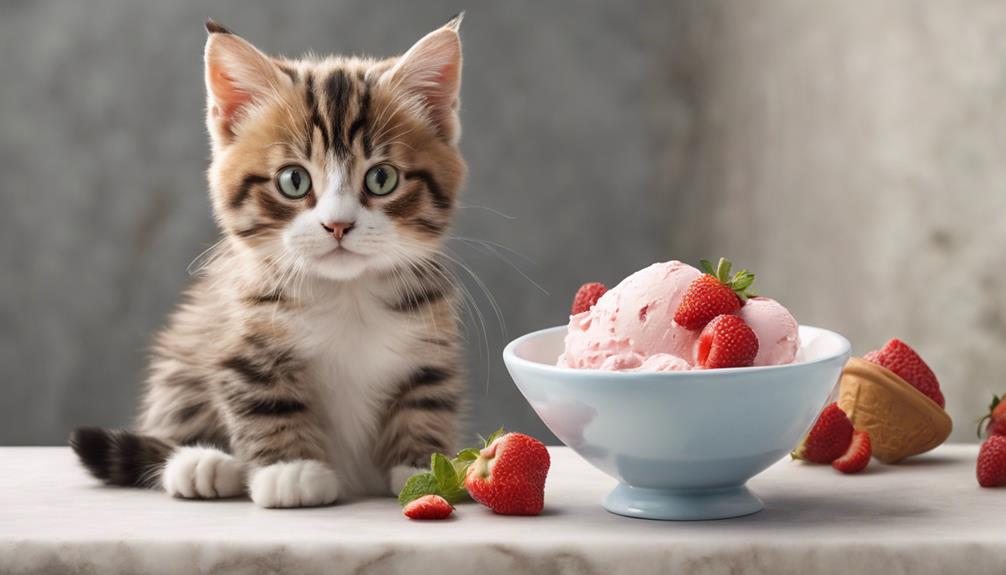
Using non-toxic ingredients in ice cream for cats is essential for ensuring their safety and well-being. When treating your feline friend, consider these non-toxic options:
- Plain vanilla ice cream without any toxic additives can be a safe and enjoyable treat for cats.
- Opt for ice cream flavors that don't contain chocolate, raisins, nuts, or artificial sweeteners to prevent digestive issues.
- Choosing ice cream made with non-toxic ingredients can provide a healthier option for your cat's occasional indulgence.
Caloric Awareness for Cats
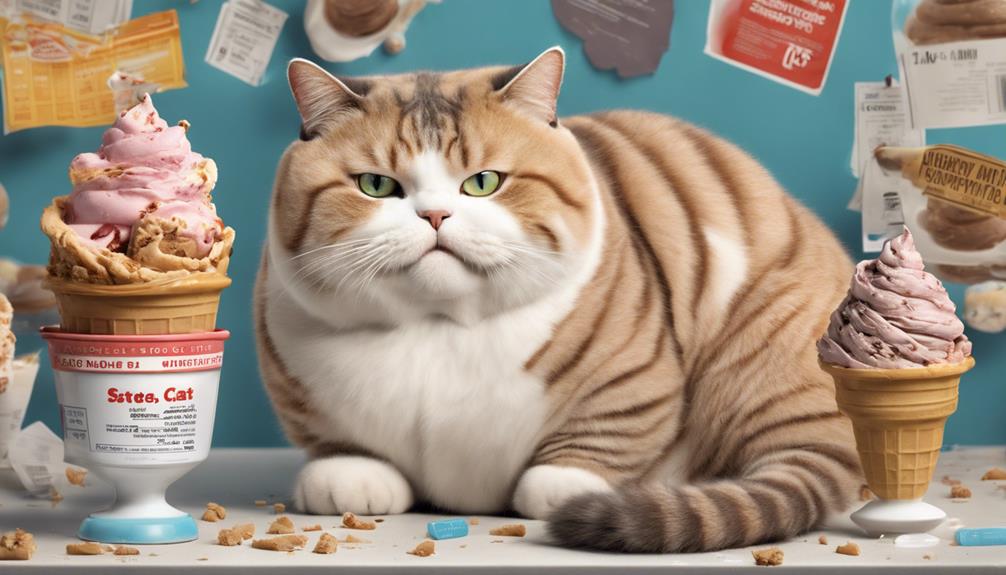
Understanding the caloric impact of feeding ice cream to cats is essential for maintaining their healthy weight and overall well-being.
Ice cream is a tasty treat for us, but for our feline friends, it can pack a caloric punch. The average vanilla scoop contains around 137 calories, which can add up quickly if given frequently. Cats have specific caloric needs based on factors like age, weight, and activity level, so it's vital to be mindful of the extras they consume.
The ingredients in ice cream also contain sugars and fats that may not align with a cat's balanced diet. Excessive consumption of high-calorie treats like ice cream can disrupt their nutritional intake and lead to unwanted weight gain.
Preventing Weight Gain in Cats
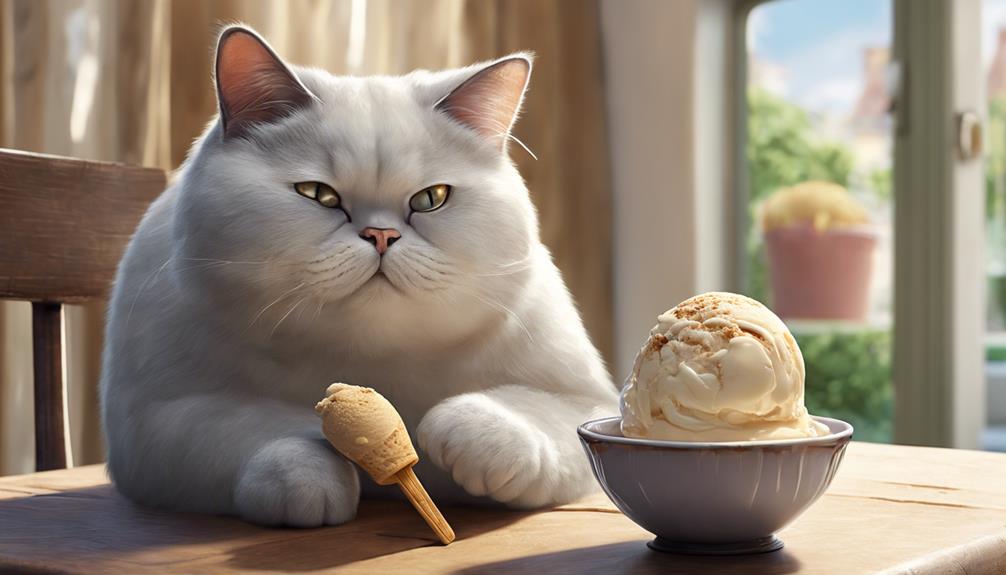
To maintain a healthy weight in cats, it's crucial to monitor their calorie intake and avoid high-calorie treats like ice cream. When it comes to preventing weight gain in our furry friends, here are some key tips to keep in mind:
- Balanced Diet: Guarantee your cat receives a well-balanced diet with appropriate portion sizes to prevent excessive weight gain.
- Active Playtime: Integrate interactive play sessions into your cat's daily routine to keep them active and help burn calories.
- Veterinary Guidance: Seek advice from your veterinarian for expert guidance on managing your cat's weight and preventing obesity.
Health Issues to Watch for
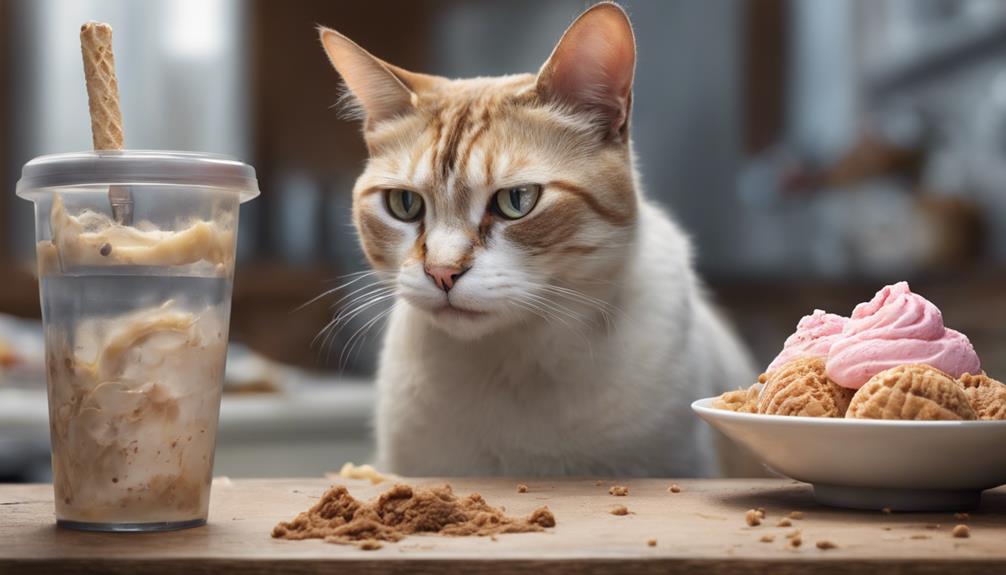
Observing for potential health issues in cats who consume ice cream is important due to the risks associated with lactose intolerance, obesity, toxic ingredients, and digestive problems. Cats, like humans, can be lactose intolerant, leading to gastrointestinal distress such as vomiting and diarrhea. The high sugar and fat content in ice cream can contribute to weight gain and obesity in our feline friends, impacting their overall health and quality of life. Moreover, certain harmful ingredients like chocolate, raisins, and artificial sweeteners found in some ice creams can be toxic to cats, posing serious health risks.
Regular consumption of ice cream can also cause digestive issues, nutritional imbalances, and even foster fussy eating habits in cats. Excessive intake may result in bloating, constipation, Irritable Bowel Syndrome (IBS), and other stomach problems. It's important to be mindful of these potential health concerns and opt for safer, cat-friendly treats to keep our furry companions happy and healthy.
Cats and Non-Dairy Treats
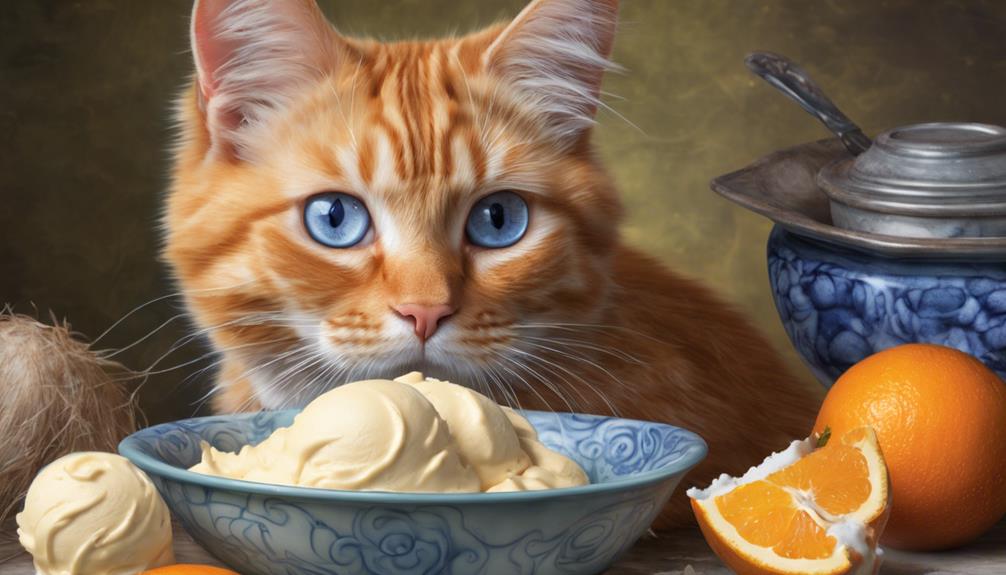
Exploring non-dairy treat options for cats reveals safe alternatives to traditional ice cream that cater to their dietary needs. When considering non-dairy treats for our feline friends, it's vital to keep in mind their delicate digestive system and the ingredients used in these treats.
- Nutritional Value: Non-dairy treats can offer a variety of nutrients beneficial to cats, such as essential vitamins and minerals, supporting their overall health.
- Digestive System: Cats may have sensitivities to certain ingredients commonly found in non-dairy treats, so it's important to introduce new treats gradually and monitor their digestive response.
- Ingredients: Opt for non-dairy treats made from wholesome ingredients that are safe for cats, avoiding artificial additives or sweeteners that could potentially harm their well-being.
Safe Ice Cream Options for Cats
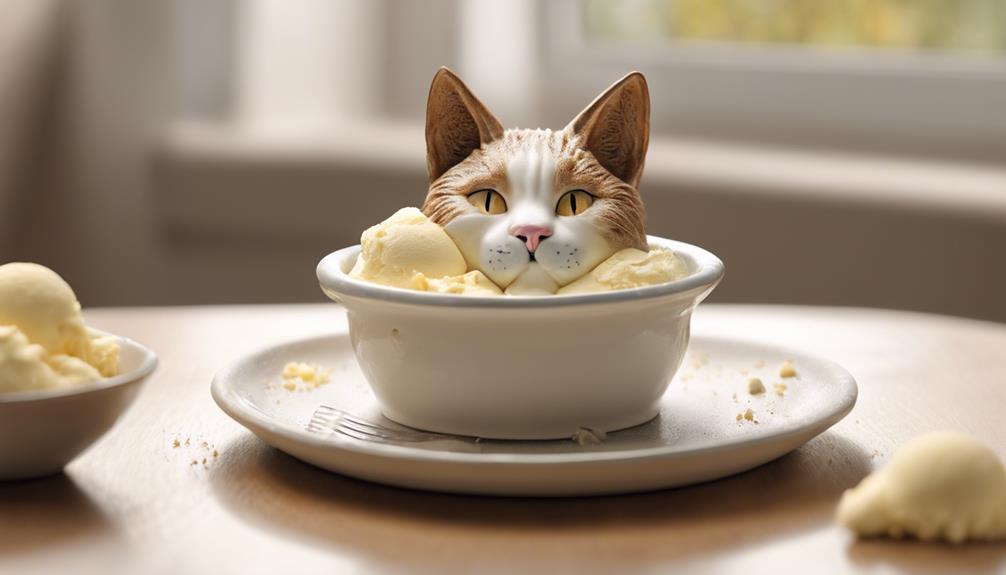
After discussing non-dairy treat options for cats, let's now shift our focus to safe ice cream choices that cater to our feline friends' dietary requirements. Cat ice cream, made with lactose-free goat milk and bonito fish flakes, offers a safer alternative for cats who enjoy indulging in frozen treats. Developed by Pet Winery, this specialized ice cream guarantees that cats avoid consuming harmful ingredients often found in regular ice cream, making it a healthier option for our beloved pets.
Cat ice cream is gentler on a cat's digestive system compared to traditional human ice cream, reducing the chances of stomach upset or other discomfort. Offering cat ice cream as an occasional treat can provide a safe and enjoyable experience for your furry companion. By opting for cat-specific treats like cat ice cream, you prioritize your cat's well-being and happiness without exposing them to the risks associated with regular ice cream.
Frequently Asked Questions
What Happens if a Cat Eats Ice Cream?
If a cat eats ice cream, it can experience gastrointestinal issues like vomiting and diarrhea due to lactose intolerance. The high sugar and fat content can lead to weight gain and potential obesity. It's best to avoid feeding cats ice cream for their health.
Is It OK to Give Cats Vanilla Ice Cream?
Giving cats vanilla ice cream is not recommended. While not toxic, it contains lactose that can lead to digestive issues. Cats should stick to their specialized, nutritious diet for best health. It's best to avoid offering them ice cream.
Is a Lick of Ice Cream Bad for Cats?
A lick of ice cream for cats is like a rollercoaster ride to tummy troubles. It can lead to upset stomachs, weight gain, and even toxic reactions. Let's keep our feline friends safe and skip the ice cream treats!
Can My Cat Lick My Ice Cream Bowl?
We avoid letting our cat lick our ice cream bowl to prevent potential health issues. Dairy products can upset their stomachs, leading to vomiting and diarrhea. Cats consuming sugar and fat regularly may face weight gain and obesity risks.
Is it Safe to Feed Plums to Cats if They Can Have Ice Cream?
Feeding plums to cats is not recommended due to potential poisoning risks. However, small amounts may be safe, but consult a vet first. On the other hand, ice cream is also not recommended for cats due to lactose intolerance. Always prioritize cats and plums safety over treats.
Conclusion
To sum up, while cats may enjoy the taste of ice cream, it isn't a safe or healthy treat for them. From lactose intolerance to potential toxic ingredients, there are many risks involved. Instead, consider offering your feline friend non-dairy alternatives or special cat-friendly treats.
Remember, their health and well-being should always come first. For example, my cat Mittens once snuck a lick of my ice cream and ended up with an upset stomach for days. It's just not worth the risk!
